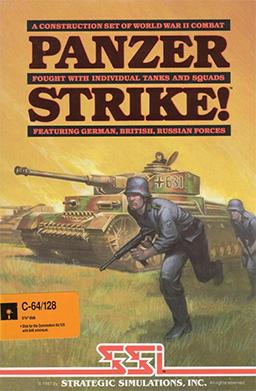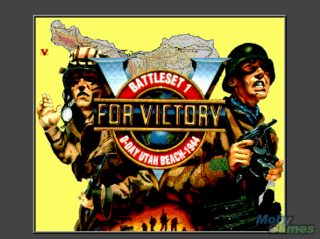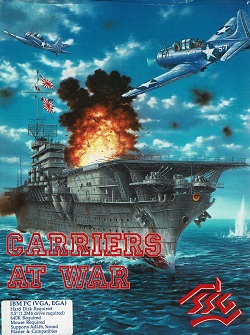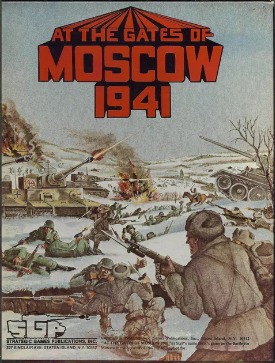
The Perfect General is a computer wargame published in 1991 by Quantum Quality Productions.

Panzer General is a 1994 computer wargame developed and published by Strategic Simulations Inc. (SSI). It simulates conflict during World War II. The designers of Panzer General were heavily influenced by the Japanese wargame series Daisenryaku.

The Battle of Velikiye Luki, also named Velikiye Luki offensive operation, started with the attack by the forces of the Red Army's Kalinin Front against the Wehrmacht's 3rd Panzer Army during the Winter Campaign of 1942–1943 with the objective of liberating the Russian city of Velikiye Luki as a previous part of the northern pincer of the Rzhev-Sychevka Strategic Offensive Operation.

Eastern Front (1941) is a computer wargame for Atari 8-bit computers created by Chris Crawford and published through the Atari Program Exchange (APX) in 1981. A scenario editor and assembly language source code for the game were also sold by APX as separate products.

Battleground 2: Gettysburg is a 1995 turn-based computer wargame developed and published by TalonSoft. It the second game in the Battleground series.

Panzer Strike is a 1988 tactical wargame that simulates small unit actions during World War II. It was made for Apple II and Commodore 64 and was released by Strategic Simulations.
Atomic Games, Inc. was an American video game developer based in Austin, Texas, specializing in wargames. The company was founded by Keith Zabalaoui in 1989, and is best known for developing the Close Combat series of real-time wargames, as well as the V for Victory series. In December 2000, due to the cancellation of a project titled Hammer's Slammers, Atomic Games laid off its entire staff, only keeping three executives. Atomic Games was acquired by Destineer on May 6, 2005, while collaborating on Close Combat: Red Phoenix and Close Combat: First to Fight. Atomic Games was developing a third-person shooter, Six Days in Fallujah, in cooperation with Konami, until the latter decided to withdraw from the project in August 2009, causing significant layoffs at Atomic Games. The company went on to finish the game, but never released it. Atomic Games released the game called Breach, which is a multiplayer-only downloadable first-person shooter. Destineer also owned Bold Games, and MacSoft, who also went down with Destineer

Battles of Napoleon is a 1988 computer wargame by Chuck Kroegel and David Landrey published by Strategic Simulations. It was released for the Apple II, Commodore 64, and DOS.
Three-Sixty Pacific was an American video game publisher and developer. Founded in the late 1980s by avid wargamers and military history enthusiasts, they were acquired by IntraCorp Entertainment Inc. in 1994.
V for Victory, or V4V for short, is a series of turn-based strategy games set during World War II. They were the first releases for Atomic Games who went on to have a long career in the wargame industry.

Gary Grigsby's Pacific War is a 1992 strategy wargame released by Strategic Simulations, Inc. It covers World War II in the Pacific between the Japanese Empire and the Allies, which include the United States, the British Empire, the Netherlands, Australia, New Zealand, Canada, the Philippines, and China. The main map of the game stretches from north of the Aleutians to southern New Zealand and Australia, and from the eastern coast of India to the West Coast of North America. It includes aircraft carrier operations, amphibious assaults, surface bombardments/engagements, strategic bombing, kamikazes, and the submarine war against naval and merchant shipping.

Harpoon is a computer wargame published by Three-Sixty Pacific in 1989 for DOS. This was the first game in the Harpoon series. It was ported to the Amiga and Macintosh.

V for Victory: D-Day Utah Beach is a 1991 computer wargame developed by Atomic Games and published by Three-Sixty Pacific. It was widely lauded and repeatedly reviewed as the best wargame of its era. Its success led to three further games in the V for Victory series, and then the similar World at War series published by Avalon Hill.

V for Victory: Market Garden is 1993 computer wargame developed by Atomic Games and published by Three-Sixty Pacific. It is part of the V for Victory video game series.

V for Victory: Gold-Juno-Sword is 1993 computer wargame developed by Atomic Games and published by Three-Sixty Pacific. It is part of the V for Victory series.

Carriers at War 1941-1945: Fleet Carrier Operations in the Pacific is a 1992 wargame by Strategic Studies Group for MS-DOS and Macintosh. It is a remake of the 1984 Carriers at War. An expansion pack, Carriers at War: Construction Kit, was released in 1993. A sequel, Carriers at War II, was also released in 1993.

Operation Crusader is a 1994 computer wargame developed by Atomic Games and published by Avalon Hill.

Kampfgruppe is a computer wargame designed by Gary Grigsby and published in 1984 by Strategic Simulations for the Apple II, Atari 8-bit computers, and Commodore 64. Kampfgruppe is a game of tactical-scale combat on the Eastern Front. An MS-DOS port was released in 1987 followed by an Amiga version in 1988.

At the Gates of Moscow 1941 (ATGOM) is 1985 video game published by Strategic Games Publications for the Apple II. Based on the board game of the same name that was released the year prior, the game was marketed in magazines as "The only board and computer game that can be played together and separately".

White Death, subtitled "Velikiye Luki, The Stalingrad of the North", is a board wargame published by Game Designers Workshop (GDW) in 1979 that is a strategic simulation of the Battle of Velikiye Luki during World War II.

















